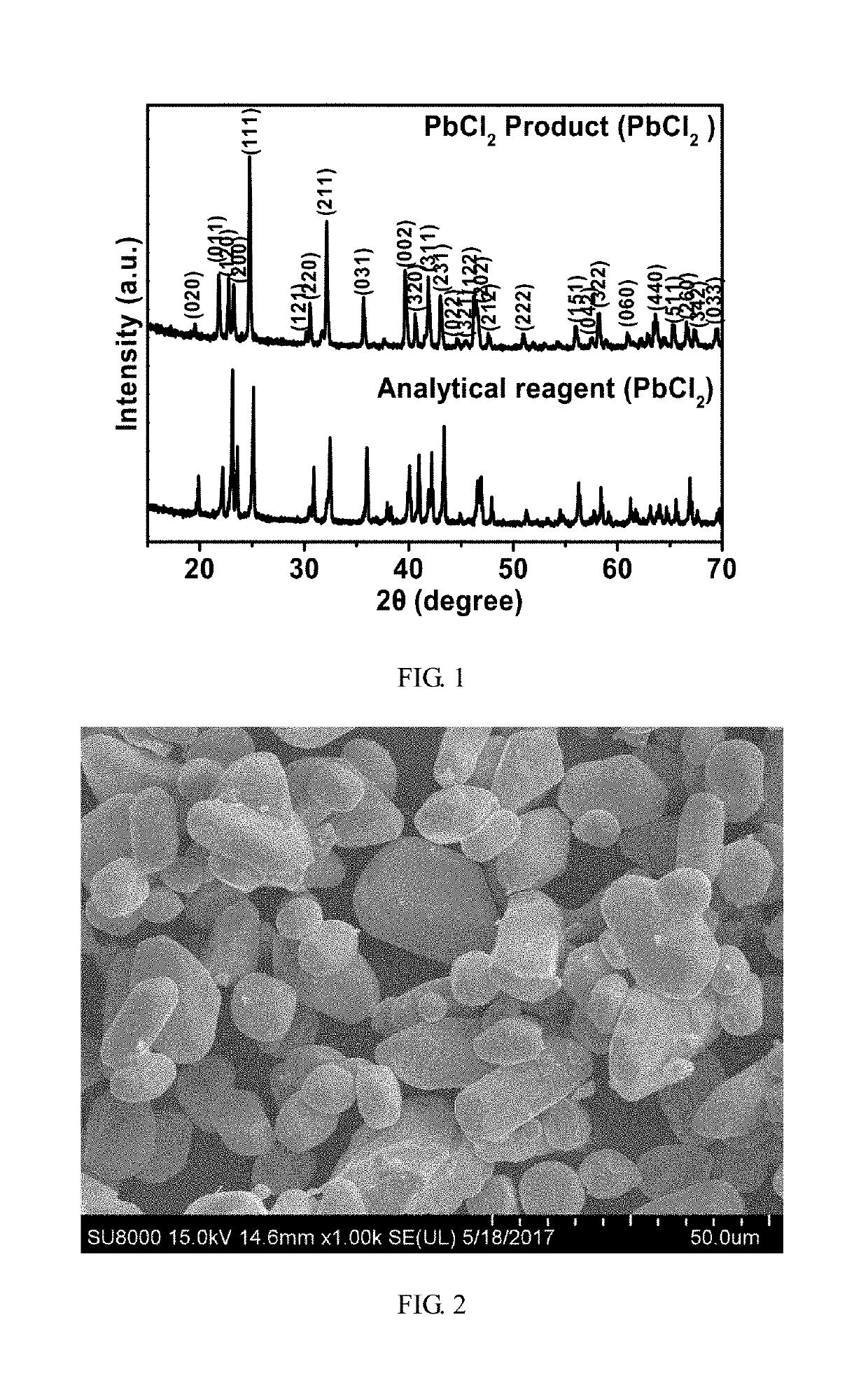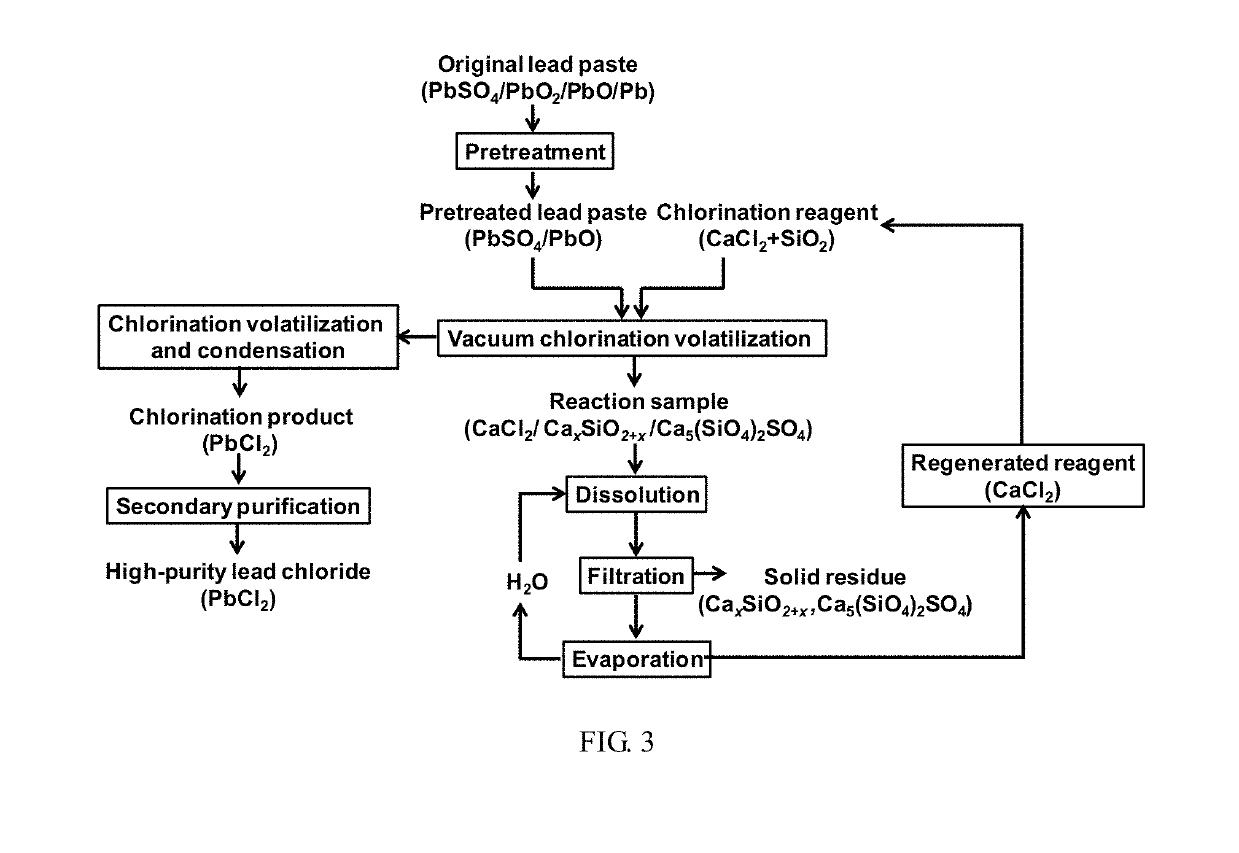Method for recycling lead paste in spent lead-acid battery
a technology of lead-acid batteries and lead paste, which is applied in the direction of lead halide, lead monoxide, cell components, etc., can solve the problems of reducing the safety of treatment, disposal and comprehensive utilization of spent lead-acid batteries, affecting human health and the environment, and a serious resource crisis in the production of mineral products in china. , to achieve the effect of reducing the risk of contamination
- Summary
- Abstract
- Description
- Claims
- Application Information
AI Technical Summary
Benefits of technology
Problems solved by technology
Method used
Image
Examples
embodiment 1
[0040]2 g of waste lead paste (the lead content of the waste lead paste is 73.5 wt %, that is, there are 7.1×10−3 mol of lead element in 2 g of waste lead paste) was calcined at a vacuum pressure of 1 Pa and 500° C. for 10 min to decompose lead dioxide in the waste lead paste into lead oxide. In addition, elemental lead is also oxidized by lead dioxide into lead oxide. The pretreated waste lead paste is uniformly mixed with a calcium chloride / silica reagent mixture having a molar ratio of calcium chloride to lead of 30:1 and a molar ratio of silica to lead of 60:1, and then heated at a vacuum pressure of 1 Pa and 400° C. for 30 min. After heating was finished, a volatilized and condensed lead chloride product was collected on the quartz tube wall. The volatilization percentage of lead chloride was calculated by calculating lead contents in the sample before and after the reaction by the acid digestion method, and thus the volatilization percentage of lead chloride was calculated to ...
embodiment 2
[0041]2 g of waste lead paste (the lead content of the waste lead paste is 73.5 wt %, that is, there are 7.1×10−3 mol of lead element in 2 g of waste lead paste) was calcined at a vacuum pressure of 1 Pa and 500° C. for 10 min to decompose lead dioxide in the waste lead paste into lead oxide. In addition, elemental lead is also oxidized by lead dioxide into lead oxide. The pretreated waste lead paste is uniformly mixed with a calcium chloride / silica reagent mixture having a molar ratio of calcium chloride to lead of 30:1 and a molar ratio of silica to lead of 60:1, and then heated at a vacuum pressure of 1 Pa and 550° C. for 30 min. After heating was finished, a volatilized and condensed lead chloride product was collected on the quartz tube wall. The volatilization percentage of lead chloride was calculated by calculating lead contents in the sample before and after the reaction by the acid digestion method, and thus the volatilization percentage of lead chloride was calculated to ...
embodiment 3
[0042]2 g of waste lead paste (the lead content of the waste lead paste is 73.5 wt %, that is, there are 7.1×10−3 mol of lead element in 2 g of waste lead paste) was calcined at a vacuum pressure of 1 Pa and 500° C. for 10 min to decompose lead dioxide in the waste lead paste into lead oxide. In addition, elemental lead is also oxidized by lead dioxide into lead oxide. The pretreated waste lead paste is uniformly mixed with a calcium chloride / silica reagent mixture having a molar ratio of calcium chloride to lead of 30:1 and a molar ratio of silica to lead of 60:1, and then heated at a vacuum pressure of 1 Pa and 650° C. for 30 min. After heating was finished, a volatilized and condensed lead chloride product was collected on the quartz tube wall. The volatilization percentage of lead chloride was calculated by calculating lead contents in the sample before and after the reaction by the acid digestion method, and thus the volatilization percentage of lead chloride was calculated to ...
PUM
| Property | Measurement | Unit |
|---|---|---|
| temperature | aaaaa | aaaaa |
| vacuum pressure | aaaaa | aaaaa |
| temperature | aaaaa | aaaaa |
Abstract
Description
Claims
Application Information
 Login to View More
Login to View More - R&D
- Intellectual Property
- Life Sciences
- Materials
- Tech Scout
- Unparalleled Data Quality
- Higher Quality Content
- 60% Fewer Hallucinations
Browse by: Latest US Patents, China's latest patents, Technical Efficacy Thesaurus, Application Domain, Technology Topic, Popular Technical Reports.
© 2025 PatSnap. All rights reserved.Legal|Privacy policy|Modern Slavery Act Transparency Statement|Sitemap|About US| Contact US: help@patsnap.com


